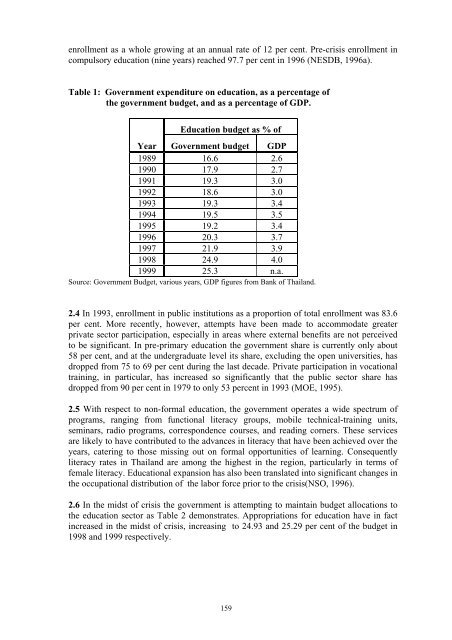Educational Finance in Thailand - UNESCO Bangkok
Educational Finance in Thailand - UNESCO Bangkok
Educational Finance in Thailand - UNESCO Bangkok
You also want an ePaper? Increase the reach of your titles
YUMPU automatically turns print PDFs into web optimized ePapers that Google loves.
enrollment as a whole grow<strong>in</strong>g at an annual rate of 12 per cent. Pre-crisis enrollment <strong>in</strong><br />
compulsory education (n<strong>in</strong>e years) reached 97.7 per cent <strong>in</strong> 1996 (NESDB, 1996a).<br />
Table 1: Government expenditure on education, as a percentage of<br />
the government budget, and as a percentage of GDP.<br />
Education budget as % of<br />
Year Government budget GDP<br />
1989 16.6 2.6<br />
1990 17.9 2.7<br />
1991 19.3 3.0<br />
1992 18.6 3.0<br />
1993 19.3 3.4<br />
1994 19.5 3.5<br />
1995 19.2 3.4<br />
1996 20.3 3.7<br />
1997 21.9 3.9<br />
1998 24.9 4.0<br />
1999 25.3 n.a.<br />
Source: Government Budget, various years, GDP figures from Bank of <strong>Thailand</strong>.<br />
2.4 In 1993, enrollment <strong>in</strong> public <strong>in</strong>stitutions as a proportion of total enrollment was 83.6<br />
per cent. More recently, however, attempts have been made to accommodate greater<br />
private sector participation, especially <strong>in</strong> areas where external benefits are not perceived<br />
to be significant. In pre-primary education the government share is currently only about<br />
58 per cent, and at the undergraduate level its share, exclud<strong>in</strong>g the open universities, has<br />
dropped from 75 to 69 per cent dur<strong>in</strong>g the last decade. Private participation <strong>in</strong> vocational<br />
tra<strong>in</strong><strong>in</strong>g, <strong>in</strong> particular, has <strong>in</strong>creased so significantly that the public sector share has<br />
dropped from 90 per cent <strong>in</strong> 1979 to only 53 percent <strong>in</strong> 1993 (MOE, 1995).<br />
2.5 With respect to non-formal education, the government operates a wide spectrum of<br />
programs, rang<strong>in</strong>g from functional literacy groups, mobile technical-tra<strong>in</strong><strong>in</strong>g units,<br />
sem<strong>in</strong>ars, radio programs, correspondence courses, and read<strong>in</strong>g corners. These services<br />
are likely to have contributed to the advances <strong>in</strong> literacy that have been achieved over the<br />
years, cater<strong>in</strong>g to those miss<strong>in</strong>g out on formal opportunities of learn<strong>in</strong>g. Consequently<br />
literacy rates <strong>in</strong> <strong>Thailand</strong> are among the highest <strong>in</strong> the region, particularly <strong>in</strong> terms of<br />
female literacy. <strong>Educational</strong> expansion has also been translated <strong>in</strong>to significant changes <strong>in</strong><br />
the occupational distribution of the labor force prior to the crisis(NSO, 1996).<br />
2.6 In the midst of crisis the government is attempt<strong>in</strong>g to ma<strong>in</strong>ta<strong>in</strong> budget allocations to<br />
the education sector as Table 2 demonstrates. Appropriations for education have <strong>in</strong> fact<br />
<strong>in</strong>creased <strong>in</strong> the midst of crisis, <strong>in</strong>creas<strong>in</strong>g to 24.93 and 25.29 per cent of the budget <strong>in</strong><br />
1998 and 1999 respectively.<br />
159

















